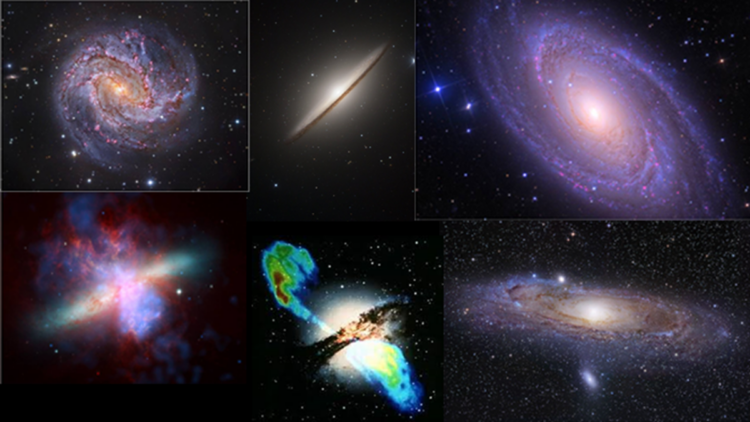
The advancement of physics has often relied on extending observational capabilities beyond natural limits. Innovations like Galileo’s pendulum clock enabled precise time measurement, laying the foundation for Newtonian mechanics. The microscope and telescope, developed around the same era, expanded our view of the micro and macro worlds. The limitations of these instruments, once deemed fundamental, were overcome through scientific advancements and new technology, such as electron microscopes exploiting wave-particle duality. Even the detection of ghost particles like neutrinos (ν), which interact weakly with matter, was achieved through large-scale experiments like Super – Kamiokande, marking the emergence of ν astronomy which deepened our understanding of the Universe.
Ghosts are supposed to appear and disappear. Most types of elementary particles are ghostly in this way. One of the ghostliest of them is the Higgs boson, whose life is expected to be ~ 10-22 s, is neutral, and has no spin. How on Earth do we see that? It is more of a poltergeist type ghost that we see by what it does. Seeing it completed our understanding of the composition of matter –– the standard model of particle physics. At the other end of the spectrum are the objects in the sky, obscured by their distance. We generally expect them to be highly energetic and violent, and hence easy to see. However, many of the sources are very faint and can be seen only in the microwave or radio bands.
Current estimate of age of the Universe 13.82 billion years ± 5 million yrs. or (1.3820 ± 0.0005)×10^10 yrs. According to the standard cosmological model of the Universe (ΛCDM)the present estimate of composition of the Universe, ~ 75% of the mass of the Universe is a vacuum or “ dark” energy; ~20% cold dark matter (CDM), and only ~5% of the normal matter (baryons; protons (p) and neutron (n)), of which about ~90% (about 4.14%) is dark and ~10% (about 0.46%) is luminous. This is the so – called “missing baryon problem”. The luminous baryons have been detected in the galactic disks; in the so called ly-α forests; in warm-hot intergalactic gas (WHIG); in the circum-galactic medium (CGM); in the intra-cluster medium (ICM); and in cold gas around the galaxies. The dark baryons are suggested to be present in the galactic halos. Galactic halos are the extended parts of the galaxies which contain much more matter than the galactic disks and these regions extend up to 300 kpc (1 kpc = 3.086 × 10^16 km) and galactic disks for Milky Way like galaxies extend up to 25 – 30 kpc.

It was proposed that “cold gas clouds” containing only molecular hydrogen exactly at the cosmic microwave background (CMB) temperature populate the galactic halos and might contain a fraction of the missing baryons. Since these clouds are formed following the virial theorem we called them “virial clouds”. Planck CMB data showed a frequency-independent temperature asymmetry towards various nearby edge-on spiral galaxies which was a strong indication for the presence of such clouds in the halos. There are other effects that might have a significant contribution to this observed temperature asymmetry which include: the rotational kinetic Sunyaev-Zeldovich (rkSZ) effect, the synchrotron emission by fast-moving electrons, the anomalous microwave emission (AME) by dust grains, and free-free emission by fast-moving electrons. It has been seen recently checked by our research group that at the present level of accuracy of Planck satellite, rkSZ has no significant contribution towards the observed temperature asymmetry, but, one has to check for other effects too.
Checking the contribution of all the other effects to the temperature asymmetry seen in the CMB can not explain the true nature of the virial clouds. We know that they are there, but, the exact chemical composition, temperature and physical parameters of these clouds are still unknown. Various toy models have been used to estimate the physical parameters of virial clouds, with and without the contamination of dust and other heavier molecules in pure molecular hydrogen clouds. Our group used these models to estimate the halo rotational velocity of M31, M33, M81, M82, M104 and NGC 5128 galaxies respectively. This still does not give us a realistic image of virial clouds. To model the clouds precisely one has to trace their evolution.
It is been proposed that the virial clouds with the primordial abundance of H and He might have been formed in the potential well of cold dark matter (CDM) at the last scattering surface (LSS) at z = 1100, when the Universe was about 3000 K, and they have evolved in their physical and chemical nature since then. Our group studied the first stage of evolution of these clouds from z = 1100, to z = 48, up to the formation of pop-III stars very precisely. At LSS the Universe contained the primordial abundances of H and He (75 % H, and 25 % He) by mass, and the ratio remained almost the same until the formation and explosion of pop-III stars. There were other molecules and atoms during the era, but their concentration was negligible compared to H and He, so these two elements were the main ingredients to form virial clouds. Our next aim is to study the evolution-II of the virial clouds, from z = 48 when the temperature of the Universe was 137 K, up to z=10 before the explosion of pop-III stars when the temperature of the Universe was 30 K.
Once the evolution of virial clouds is completely studied we can start from the scratch and will model the proper rotation of dark halos with the contribution of all the other possible effects causing a temperature asymmetry in the CMB Planck data. This will help us to put an upper bound on the dark baryons and we will then start looking for rest of the baryons.
Collaborating Institutions:
- Department of Mathematics and Physics “Ennio De Giorgi”, University of Salento, Via per Arnesano, 73100, Lecce, Italy.
- INFN, Sezione di Lecce, Via per Arnesano, 73100, Lecce, Italy.
- INAF, Sezione di Lecce, Via per Arnesano, 73100, Lecce, Italy.
- Instituto de Astrofisica de Canarias, 38200 La Laguna, Tenerife, Spain.
- Departamento de Astrofisica, Universidad de La Laguna, La Laguna, Teneriefe, Spain
The author is an Assistant Professor at Department of Physics, School of Natural Sciences (SNS), National University of Sciences and Technology (NUST). He can be reached at noraiz.tahir@sns.nust.edu.pk.
Research Profile: https://bit.ly/3UkGmk6

![]()




